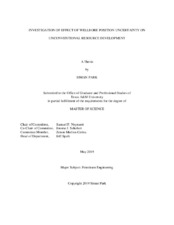Investigation of Effect of Wellbore Position Uncertainty on Unconventional Resource Development
Abstract
The Eagle Ford Shale is one of the largest unconventional oil plays where a large number of horizontal wells with hydraulic fractures have been developed in recent years. Due to its very low permeability, operators complete a fair number of the horizontal wells, with their “ideal” well spacings, from the same surface location to produce estimated unconventional reserves. The problem is; operators typically develop horizontal well positions by assuming parallel, fixed spacing to maximize production and call it “optimized” spacing. This generalized well spacing is approximated as a single number and treated as having no positional uncertainty of wellbores. However, each wellbore has a wide range of positional uncertainty due to survey errors caused by Measurement While Drilling (MWD) and this positional uncertainty, in turn, leads parallel spacing to a meaningless optimization. Furthermore, these positional errors produce an uncertain magnitude in levels of hydraulic fracture communication between horizontal wells and have an impact on well performance. Such uncertainty depends obviously upon well spacing as well as wellbore positions, but inaccurately positioned wellbores do not convey the fracture communication level clearly. Within the context of publicly available data, this study evaluates possible cases of wellbore position uncertainty based on MWD error sources for five selected well pads in Burleson County. It provides an estimate to how far the wellbores can be deviated from their parallel positions. By using simulation models and comparing well performances between the parallel positions and practical positions estimated, this study investigates actual wellbore positions. It, then, analyzes the effects of positional changes coupled with fracture communication level on long-term well performance, in terms of Estimated Ultimate Recovery (EUR), to show the wide range of uncertainty in reserve estimates.
These large positional errors of wellbores produce considerable differences in the cumulative oil production, because the extent of drainage radiuses overlapped by fractures of two wells in staggered configurations changes due to wellbore positional changes. These results show that 10-year total EURs of two wells in parallel positions are overestimated by up to 10.7% due to 1.2% - 5.8% probability of causing positional errors compared to their actual positions. The other well pad whose actual well performances are lower than the expected performances of the two wells in a parallel position produces a gross under-estimate of EUR by 9.8% due to positional errors with 9.1% probability of occurring. In addition, a single well that has longer fractures than the other well in the same pad has more impact on EUR due to a strong effect of fracture communication. These wide ranges of uncertainty in reserve estimates clearly show operators should consider positional errors of wellbores with a probabilistic aspect to avoid over- or under-estimates of reserves that in turn, lead to unexpected economic returns. Using standard MWD tool sets for improved survey, such as multi In-Field Referencing (IFR) and Multi-Station Analysis (MSA) can reduce much of the wellbore position errors. Minimizing wellbore position uncertainty is an important process in the unconventional developments to establish the validity of reserve estimates when horizontal well spacings are optimized.
Citation
Park, Siman (2019). Investigation of Effect of Wellbore Position Uncertainty on Unconventional Resource Development. Master's thesis, Texas A & M University. Available electronically from https : / /hdl .handle .net /1969 .1 /185078.


